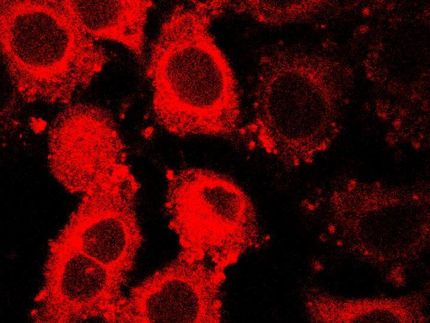Biosensor 'bandage' collects and analyzes sweat
Like other biofluids, sweat contains a wealth of information about what's going on inside the body. However, collecting the fluid for analysis, usually by dripping or absorbing it from the skin's surface, can be time-consuming and messy. Now, researchers have developed a bandage-like biosensor that both collects and -- in conjunction with a smart phone -- analyzes sweat. The device, which could someday help diagnose diseases, is reported in ACS' journal Analytical Chemistry.

Biosensor bandage before (left) and after (right) sweat secretion.
American Chemical Society
Compared with other biofluids such as blood, sweat has the potential to be obtained less invasively for diagnostic testing. Researchers have developed tools to collect and analyze sweat, such as temporary tattoos or microfluidic devices, but they typically require wires, electronics or sophisticated structures. Tailin Xu, Li-Ping Xu, Xueji Zhang and colleagues wanted to make a wearable biosensor resembling a bandage that samples sweat and uses a simple color-changing assay to quantify various components.
To make their device, the researchers coated a flexible polyester film with a super-hydrophobic silica suspension. They then etched microwells into the silica layer to collect perspiration. At the bottom of the wells, they placed dyes that change color with pH or concentration of chloride, glucose or calcium. The team added an adhesive backing and attached the biosensor bandage onto a volunteer's skin. When the person exercised, their perspiration collected in the microwells, and the spots changed colors. By imaging and analyzing the colors with a cell phone, the researchers determined that the sweat pH was 6.5-7.0, with a chloride concentration of about 100 mM and trace amounts of calcium and glucose. The researchers are now working on increasing the sensitivity of the device.
Original publication
These products might interest you

Octet R2 / Octet R4 / Octet R8 by Sartorius
Full power on 2, 4 or 8 channels: Label-free and GxP-compliant analysis of molecular interactions
Innovative label-free real-time protein quantification, binding kinetics and rapid screenings

Octet RH16 and RH96 by Sartorius
Efficient protein analysis for process optimisation and manufacturing control in high-throughput
Label-free protein quantification and characterization of protein-protein interactions

Octet SF3 by Sartorius
Surface Plasmon Resonance (SPR) using Single Dynamic Injections for Kinetics and Affinities
Curvature is Key - Adding a ‘Third Dimension’ to the Binding Curve

Get the analytics and lab tech industry in your inbox
By submitting this form you agree that LUMITOS AG will send you the newsletter(s) selected above by email. Your data will not be passed on to third parties. Your data will be stored and processed in accordance with our data protection regulations. LUMITOS may contact you by email for the purpose of advertising or market and opinion surveys. You can revoke your consent at any time without giving reasons to LUMITOS AG, Ernst-Augustin-Str. 2, 12489 Berlin, Germany or by e-mail at revoke@lumitos.com with effect for the future. In addition, each email contains a link to unsubscribe from the corresponding newsletter.























































